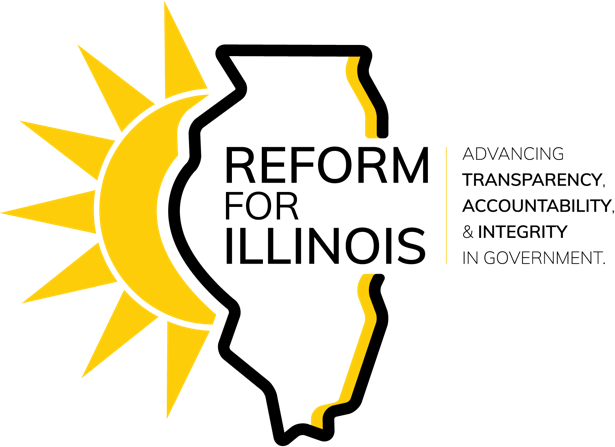Billionaires, labor, party leaders spend big in lead-up to Election Day 2022
As November 8 approaches, big money is flooding races across Illinois. Party leaders are spending heavily to support their candidates, Dick Uihlein is stepping up to (maybe) fill Ken Griffin’s shoes, and labor is fighting for a state constitutional amendment.
We took a look at recent fundraising and spending in key races.
Takeaways:
- It’s labor versus Uihlein (and Jeanne Ives?) in the battle for Amendment 1. The campaign in favor of the Workers’ Rights Amendment is well-funded and spending big on advertisements. The opposition is funded largely by billionaire Dick Uihlein and has spent on mailers and canvassing, but so far is absent from the airwaves. Former state representative and gubernatorial candidate Jeanne Ives is backing a second committee to oppose the amendment, but we’ve seen little activity from it as of yet.
- Republicans fight to keep DuPage County Chair seat – and the race has ties to a new PAC worth watching. Greg Hart (R) has over $1.5 million cash on hand – more than double what opponent Deb Conroy (D) has available. Hart is also listed as one of the candidates supported by a new Washington D.C.-based PAC called The Firewall Project.
- Legislative leaders use the self-funding loophole to rake in cash and distribute it to other races. Speaker Welch and President Harmon reported hauls of $7 million and $4.8 million, respectively, massively outraising their Republican counterparts.
- Democrats are spending big to protect their supermajorities. Legislative leaders of both parties moved more than $16 million combined to party committees during the third quarter. Since the quarter’s reporting deadline, five additional contributions to party committees from Speaker Welch ($9.6 million and $2.1 million), Leader Durkin ($50K and $500K), and Leader McConchie ($600K) bring that figure up to just over $29 million. The money is pouring into statehouse races, especially into Democrats’ accounts, with $300K–$500K transfers becoming common in October and competitive races like state Sen. Doris Turner’s receiving $1 million+.
- Lightfoot is burning through cash in the Chicago mayoral race. Lightfoot has less cash on hand than her predecessor, Rahm Emanuel, during the same quarter in 2014. A few notable names are still contemplating a run before the November 28th petition deadline.
- Big money in the Illinois Supreme Court races. Judge Elizabeth Rochford (D) and Judge Mary Kay O’Brien (D) have large fundraising advantages over their opponents, Mark Curran (R) and Justice Michael J. Burke (R). A recent ruling that temporarily blocked two new campaign finance restrictions may bring even more super PAC spending in these races.
- The money race is settled in the Secretary of State’s race. Alexi Giannoulias (D) has a massive cash advantage compared to Dan Brady (R).
- Billionaires JB Pritzker and Dick Uihlein are the twin titans of the gubernatorial race. With polls showing a significant lead for the incumbent governor, Pritzker is spending generously to support down-ballot Democrats. Billionaire Illinoisan Dick Uihlein is back to funding Republican Darren Bailey’s campaign and the People Who Play By the Rules super PAC spending millions on anti-Pritzker ads.
- The anti-Pritzker, Uihlein-funded People Who Play By The Rules super PAC headed by Dan Proft has expanded its reach beyond the governor’s race. The committee has spent over $280K so far to support Republican candidates and oppose Democrats in Illinois House, Senate, and Supreme Court races.
Special thanks to RFI Research Assistant Annie Dhal for her assistance in preparing this quarterly report.
Amendment 1
Labor is out in force to support Workers’ Rights Amendment; anti-Amendment 1 committee sees support from Uihlein, possibly Ives?
Illinoisans will vote on a constitutional amendment this fall to enshrine the right to collective bargaining in Illinois’ state constitution. Labor groups poured significant cash into the committee to support the amendment, Vote Yes for Workers Rights, back in the second quarter – and that trend continued into the third quarter.
The Vote Yes for Workers Rights ballot initiative committee raised $5.8 million this quarter, down slightly from a $6.4 million haul last quarter. Four $1 million contributions from the Great Lakes Regional Organizing Committee, United Brotherhood of Carpenters and Joiners of America, UA of Journeymen & Apprentices of the Plumbing & Pipefitting Industry, and Illinois Pipe Trades PEF (transfer) made up the bulk of the committee’s fundraising. Vote Yes for Workers Rights has already raised an additional $1.4 million in the first few weeks of the fourth quarter, leaving the committee with $3.7 million available to spend ahead of the general election.
Vote Yes for Workers Rights spent heavily this quarter, reporting $6.4 million in expenditures between July and the end of September. The committee spent big on various forms of media: $4.8 million went to broadcast television advertising, another $338K went to YouTube advertising, $230K went to streaming-specific advertising, and $70K went to radio. With $3.7 million in its campaign account, we can expect that Vote Yes for Workers Rights will continue its ad blitz until Election Day.
There are two new committees opposing the amendment: Vote No on Amendment 1, created in early September, and the Vote Against Amendment One Committee, created in late September.
Vote No on Amendment 1 is the better-funded of the two, with $1 million in reported contributions during the third quarter and $2.6 million cash on hand currently. Dick Uihlein is the committee’s largest donor, having contributed $1 million to the committee in early September (the sole donation to the committee in the third quarter) and another $1 million on October 20th. Uihlein’s involvement in the campaign against Amendment 1 may be a harbinger of future spending by the Vote No on Amendment 1 committee in the final weeks before the election. The committee reported three new donors in October: the Government Accountability Alliance ($1 million); Kristine Losby of Peoria, IL ($1K); and Peoria County Republican Women ($1K). Vote No on Amendment 1’s expenditures totaled $337K this quarter, with $250K (or 74%) spent on a website. The committee currently has $2.6 million cash on hand.
Vote Against Amendment One, in contrast, has raised just $24K since September 30th. (The committee’s third quarter report did not disclose any contributions or expenditures. Given that Vote Against Amendment One was created on September 28th, this is not shocking.) Four donors have been reported: Breakthrough Ideas, a 501(c)(4) run by former Illinois State Rep. and gubernatorial candidate Jeanne Ives ($20K); Illinois State Rep. Tim Ozinga ($2.5K), Anne Reilly, owner of Reilly International ($1K); and Jeanne Ives herself ($1K). No expenditures have been reported by Vote Against Amendment One to date.
For comparison, the committee created to oppose the Fair Tax Amendment in 2020, the Coalition to Stop the Proposed Tax Hike Amendment, raised $48.1 million during the same quarter in 2020. The committee spent $21 million during that period, and began the final few weeks before Election Day with $27 million in its campaign coffers. The bulk of the committee’s fundraising came from billionaire now-almost-former Illinoisan Ken Griffin – $53 million over the course of the campaign – suggesting that Griffin’s apparent exit from Illinois politics is acutely felt in this anti-Amendment 1 fight.
Dick Uihlein’s $2 million cumulative contribution to the Vote No on Amendment 1 committee does represent an increase from 2020, when the billionaire Illinoisan contributed just $100K to the Coalition to Stop the Proposed Tax Hike Amendment. Even still, Uihlein has big, Griffin-sized shoes to fill.
DuPage County Chair
Republicans don’t want to lose this seat; Hart has ties to PACs we’re watching
Though we haven’t covered the race for DuPage County Chair before, the big money in this race recently drew our attention.
Current DuPage County Chairman Dan Cronin (R) has held the seat for more than a decade, and Democrats view this county chair seat as a prime pickup opportunity.
Illinois State Rep. Deb Conroy (D) will face current DuPage County Board member Greg Hart (R) on November 8th. Neither Conroy nor Hart have been subject to contribution limits since the primary, when an independent expenditure committee blew Hart’s contribution caps. (The Illinois State Board of Elections has not yet updated its website to show the name of the independent expenditure committee in question.)
Rep. Conroy is well-funded, with about $744K in her campaign coffers. She brought in $272K in contributions during the third quarter, and her largest contributions came from LiUNA Chicago Laborers’ District Council Political Action Committee ($59.9K), JB for Governor Exploratory Committee ($54.9K), and The People for Emmanuel “Chris” Welch ($50K). Conroy spent $205K total this quarter, with her largest expenditures being a transfer to the Democratic Party of Illinois ($100K) and polling-related expenses ($24K).
In contrast, Greg Hart’s current cash on hand is $1.5 million, more than double Conroy’s. His contributions this quarter totalled $576K, in addition to $123K in in-kind contributions. The Illinois Republican Party accounted for most of that $123K figure: the party spent $114K on mailing and printing for Hart’s campaign. Hart spent $456K this quarter, with transfers to the Illinois Republican Party ($170K) and television ads ($124K) topping the list of his highest expenses. Hart appears to be bulking up his campaign account in the final two weeks before Election Day: he received a $400K loan from Kendall Investments on October 20th.
Even more interesting than Hart’s high-dollar fundraising are his ties to other committees on our radar this fall. The Firewall Project is a new PAC that we first covered in our piece about the money in Illinois’ two Supreme Court races. In addition to supporting Justice Burke (R) and Mark Curran (R) in their Supreme Court races, the committee has also signaled it will support Hart’s bid for DuPage County Chair. The Firewall Project has $1 million available to spend and no reported expenditures to date, though we expect spending to ramp up soon.
The Firewall Project is based in Washington, D.C. and is run by Thomas Datwyler, a GOP operative who has created PACs in several states across the country. Datwyler recently created a new super PAC, formally based in Wisconsin, that is called Families for a Safer Illinois. The super PAC currently has $541K cash on hand, all of which comes from RSLC PAC, the PAC connected to the Republican State Leadership Committee. The super PAC’s mission is “to address crime, corruption, and the cost of living in Illinois.” So far it has spent over $135K in independent expenditures to oppose Democratic candidates for the Illinois House and Senate. It is unclear whether the super PAC plans to support Hart’s campaign, but its connection to the Firewall Project is an example of how local, regional, and national groups are interacting to advance partisan goals in Illinois.
Hart is also connected to a new PAC called Moving DuPage Forward. Moving DuPage Forward has $69K in its campaign account currently, though it has not contributed to Hart’s campaign yet. Interestingly, most of the PAC’s support comes from longtime Republican donors like David MacNeil, CEO of Weathertech, and Patrick Ryan, the founder of Aon Corporation.
Legislative Leaders
Campaign cash bonanza for Democrats, strong showings by Republicans too; all four leaders transfer significant cash to party committees and statehouse races
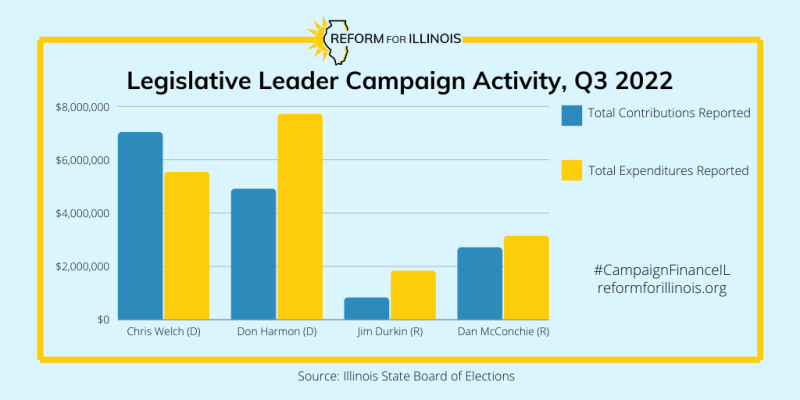
A huge wave of money has been hitting Illinois’ legislative leaders’ campaign accounts in advance of November 8th. Illinois House Speaker Chris Welch and Illinois Senate President Don Harmon bested their Republican counterparts, Leaders Jim Durkin and Dan McConchie, in the money race again this quarter. Welch raised 8.5 times Durkin’s haul, while Harmon raised 1.8 times McConchie’s. Welch raised more than Harmon this quarter, in a reversal from the second quarter of 2022.
Speaker Welch reported a massive $7 million haul in the third quarter. His largest donor this quarter was the Engineers Political Education Committee Separate Education Fund, which transferred $1 million to his campaign account. The Engineers Political Education Committee became Welch’s largest overall contributor last quarter – as we wrote about at the time – and has now contributed $2.76 million to his campaign to date. A single transfer accounts for the vast majority (or 89%) of Welch’s $5.5 million in reported expenditures this quarter: $4.95 million to the Democratic Party of Illinois. Welch spent just $650K in the second quarter, demonstrating just how expensive the immediate period before a general election can be. He currently has $13.7 million available to spend.
Senate President Harmon raised $4.8 million this quarter, up from his $3.4 million haul last quarter. His largest contribution matches Welch’s exactly: $1 million from the Engineers Political Education Committee Separate Education Fund. Harmon spent heavily this quarter – $7.7 million total, compared to $161K during the second quarter. His largest expenditure this quarter, again similar to Welch, is a $7 million transfer to ISDF, the Democratic Senate caucus committee controlled by Harmon himself. Harmon has $14.7 million in his campaign account in the final weeks before Election Day.
Leader McConchie bested House Minority Leader Durkin in the money race this quarter, reporting a $2.6 million total haul. Dick Uihlein donated $2.2 million to McConchie’s campaign committee in the third quarter, representing about 83% of his total fundraising. McConchie’s spending also ramped up this quarter, for a total of $3.1 million. Just like Speaker Welch and President Harmon, McConchie’s largest expenditures were transfers to party committees. In McConchie’s case, he transferred $2.9 million to the Senate Republican Victory Fund. McConchie ended the quarter with $1.2 million cash on hand, and has since increased that figure to $2.4 million.
Leader Durkin raised $820K during the third quarter, a decrease from his $1.4 million haul last quarter. Durkin’s largest contribution is a $100,001 self-loan from early July to reach the self-funding threshold, as we covered extensively in our second quarter report. His next largest contribution comes from the Health Care Council of IL PAC, which transferred a total of $100K to his campaign in August and September. Durkin’s expenditures totalled $1.8 million, $1.3 million of which were transfers to the House Republican Majority. (Exactly like Leader McConchie, Speaker Welch, and President Harmon.) He has $1.7 million in his campaign coffers.
Party Committees
Democratic party committees: Flush with cash from party leaders, spending is up to support Democratic statehouse candidates
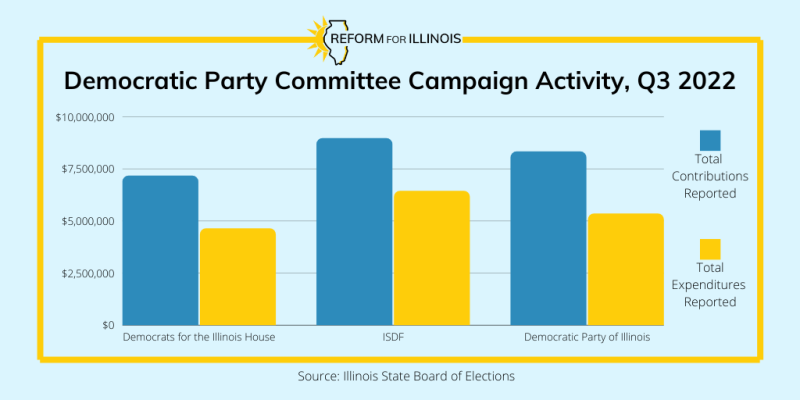
After two back-to-back slow quarters, the third quarter finally saw an influx of campaign cash for the three Democratic party committees.
Speaker Welch’s Democrats for the Illinois House raised $7.1 million this quarter, an increase of $6.9 million from the committee’s second quarter haul. Most of that came from Gov. Pritzker, who contributed $6 million to Democrats for the Illinois House in August and September as part of his strategy to support Democrats up and down the ballot. And Speaker Welch isn’t missing out on the action either: he contributed $9.6 million and $2.1 million to Democrats for the Illinois House in October after last quarter’s reports were due. Democrats for the Illinois House reported significantly higher expenditures this quarter ($4.6 million), with over $1.8 million spent on digital ads supporting Democratic House candidates. The committee ended the quarter with $5.8 million cash on hand, and Speaker Welch’s recent contributions (and a few others) brought the committee’s current cash on hand up to $17.7 million.
Democrats for the Illinois House has been on quite the spending spree recently: Illinois House candidates have received transfers of up to $382K on October 17th and 18th, with similar amounts going to candidates in the following days.
ISDF, the Senate Democratic caucus committee controlled by President Harmon, reported an $8.9 million haul in the third quarter. President Harmon’s $7 million transfer to ISDF accounts for the vast majority of that fundraising, though Gov. Pritzker also transferred $1 million to the committee in August. Within ISDF’s $6.4 million in reported expenditures, the largest went to candidates in competitive races: Friends of Suzy Glowiak (Glowiak’s district was redrawn) received $1 million, and Friends of Doris Turner received $1.2 million. ISDF had just over $4 million in its campaign account at the close of the third quarter, and its account balance now stands at $10.1 million.
The Democratic Party of Illinois (DPI) came in just behind ISDF in the money race with an $8.3 million third quarter haul. Speaker Welch provided about half of that sum with his $4.95 million transfer to DPI in August. JB for Governor contributed another $3 million to the committee during the third quarter. A third of that contribution was returned to Gov. Pritzker, though, when DPI spent $1 million – the committee’s largest expenditure this quarter – on a mailing for the governor. Pritzker has since contributed another $6 million to DPI in October. The Democratic Party of Illinois has an impressive $10.1 million available to spend in the final weeks before Election Day, which might suggest stronger party fundraising under new, Pritzker-backed DPI Chair Lisa Hernandez.
Republican party committees: Still overwhelmed by their Democratic counterparts, but also getting party leader cash and spending heavily in support of Republican IL House, Senate, gubernatorial, county chair candidates
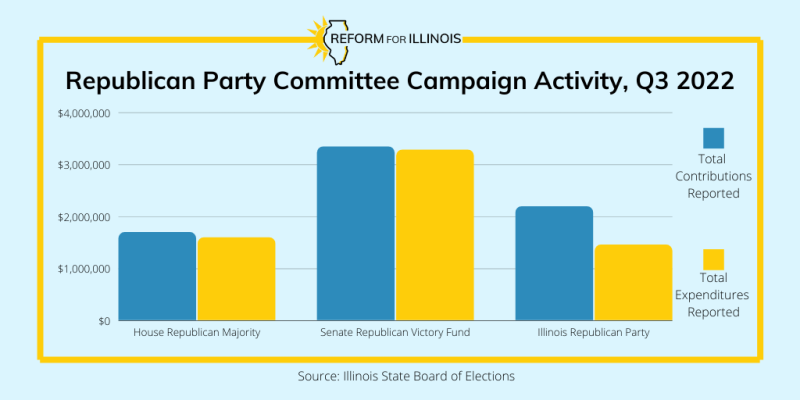
Note: We usually cover the House Republican Organization, but the newer House Republican Majority has more reported contributions and expenditures this quarter.
The House Republican Majority raised $1.6 million in the third quarter, up from a $905K haul in the second quarter of 2022. Much like the committee’s Democratic counterparts, the House Republican Majority received most of its total fundraising from party leader contributions: Leader Durkin transferred $1.3 million, representing 76% of the committee’s total haul. As for expenditures, the House Republican Majority spent $1.5 million, with $750K transferred to the Illinois Republican Party and another $246K spent on polling for various Republican House candidates. The committee has fundraised extensively in the first few weeks of the quarter – bringing in over $2.2 million – and has $2.4 million in its campaign account.
The Senate Republican Victory Fund reported a $3.3 million haul, the bulk of which (86%) came from Leader McConchie’s $2.9 million transfer. The committee spent $3.2 million in total, almost exactly as much as it raised this quarter. The Illinois Republican Party received $650K, and three Republican Senate candidates received an additional $1.9 million in transfers: $746K went to Erica for Illinois, which is the candidate committee for Erica Conway Harriss (56th District); $645K went to Thoms for Senate, which is the candidate committee for Mike Thoms (36th District); and $564K went to SandyforSenate, which is the candidate committee for Sandy Hamilton (48th District). The Senate Republican Victory Fund currently has $2.4 million cash on hand.
The Illinois Republican Party had the second highest fundraising haul among Republican party committees this quarter, coming in at $2.1 million. Transfers from the House Republican Majority and the Senate Republican Victory Fund accounted for $1.4 million of that total. Darren Bailey’s candidate committee, Bailey for Illinois, was the committee’s next largest contributor this quarter ($150K). The Illinois Republican Party spent $1.4 million during the third quarter, and its two largest reported expenses were for mailing and printing for DuPage County Chair candidate Greg Hart ($75K) and for mail and postage fees for Darren Bailey ($74K, in-kind). The Illinois Republican Party has the highest available cash on hand (again compared to the other two Republican party committees) at $4.2 million.
Chicago Mayoral
Lightfoot burns through cash, still waiting for the field to solidify
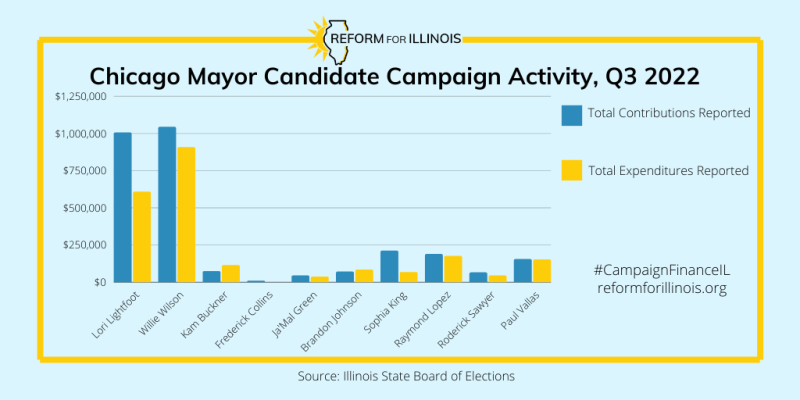
Mayor Lori Lightfoot raised just over $1 million during the third quarter, down slightly from her $1.2 million haul last quarter. Lightfoot’s largest contribution was a $150K transfer from the Carpentry Advancement Political Action Committee Fund. Her other largest contributions were a trio of $50K donations from Laura Ricketts, political activist and former attorney; Fred Eychaner, entrepreneur and major Democratic donor; and Mary Dempsey, President of DePaul College Prep. A miniscule 0.96% of Lightfoot’s contributions this quarter came from contributions of up to $150.
Lightfoot spent $607K this quarter, with her largest expenditures going towards consulting-related expenses (over $160K) and research ($84K). She ended the quarter with $2.9 million available to spend, and her campaign account currently sits at $3 million.
As outlets have reported, Lightfoot has a high “burn rate” for this stage of the campaign, meaning she is spending almost as much as she raises. She also has a smaller amount of cash on hand than would be expected for an incumbent mayor, particularly one with low approval ratings who has reason to be concerned about their chances. For comparison, former Mayor Rahm Emanuel raised $1.1 million during the third quarter of 2014 – as he was mounting a reelection bid for a second term – but had over $8.6 million cash on hand at the close of the quarter.
The third quarter money race was remarkably close between two candidates: businessman Willie Wilson edged out Lightfoot by about $37K, for a total haul of just over $1 million. Over 95% of Wilson’s total haul, though, came from a single $1 million loan to himself on August 29th. Wilson’s other donations this quarter all came in at $9K or less, and he received an abysmal 0.34% of his total fundraising from small contributions of up to $150.
Wilson reported $906K in expenditures during the third quarter, and his highest spending category was for television, radio, and newspaper advertising ($389K). This is especially notable given that Lightfoot did not air any radio or television advertisements during the third quarter. A notable Wilson expenditure went to RRB Strategies LLC for consulting ($10K), which is run by disgraced former governor Rod Blagojevich. Wilson has $4.6 million available to spend.
Other Chicago mayoral candidates did not come close to matching Lightfoot or Wilson’s fundraising totals this quarter. Ald. Sophia King raised $210K, Ald. Raymond Lopez reported a $187K haul, and Paul Vallas raised $153K. State Rep. Kam Buckner reported earning $72K, Ald. Roderick Sawyer raised $63K, Ja’Mal Green earned $42K, and Frederick Collins reported $5K. Finally, newly announced mayoral candidate and Cook County Board Commissioner Brandon Johnson reported receiving $69K in the third quarter of 2022. Johnson was recently endorsed by the Chicago Teachers Union and could become the progressive standard bearer in this race.
Though Lightfoot and Wilson are the clear leaders in the money race right now, the mayoral field isn’t set in stone just yet. Petitions for mayoral candidates are due on November 28th, and a number of notable names are still weighing a run for City Hall. U.S. Rep. and former mayoral candidate Chuy García is one of them, as are Ald. Tom Tunney and former governor Pat Quinn. We’ll have a better sense of the candidates drawing the most financial support – likely from well-resourced PACs, industry donors, and wealthy Chicagoans – once we know exactly who’s on the ballot.
Supreme Court
We published a piece last week to explain how to follow the money in Illinois’ two Supreme Court races. We hope you read it, especially to learn more about the dark money groups, PACs, and super PACs active in these races.
2nd District: Caps are off again, Rochford leads in the money race & Curran ramps up fundraising in October
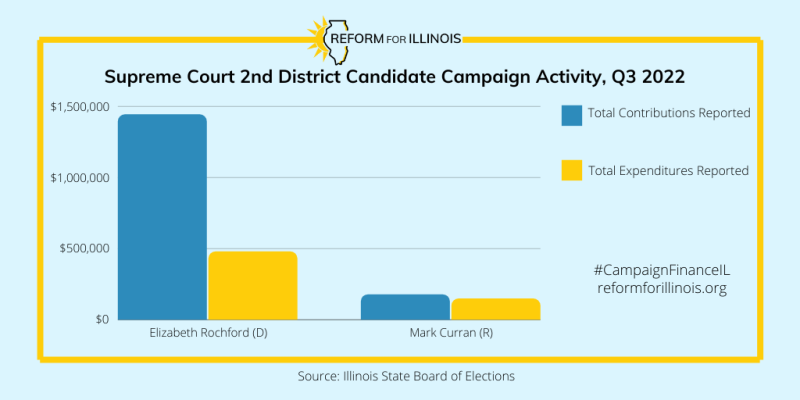
Read our report on the money in Illinois’ Supreme Court races here.
Judge Elizabeth Rochford (D) ramped up her fundraising in the third quarter, reporting a $1.4 million haul compared to $479K in the previous quarter. Her largest contribution was a $500K transfer from JB for Governor. Rochford’s other top contributors were AFSCME Illinois Council No 31 PAC ($60K transfer) and LCFT-COPE Local 504 IFT-AFT/AFL-CIO ($30K transfer). Rochford also received 26 $12K donations from 25 different law firms (such as The Gori Law Firm, P.C. and Tomasik Kotin & Kasserman LLC) this quarter. A $51K in-kind contribution from Personal PAC for voter ID calling (to gauge the partisanship of voters in the 2nd District) rounded out Rochford’s top contributions this quarter.
Rochford actually spent less between July and the end of September ($479K) than she did in the previous quarter ($612K). Her largest expense was a $307K digital media buy, with polling ($45K) and consulting/fundraising services (over $80K) as her next largest expenses. Rochford ended the quarter with just over $1 million cash on hand and has raised over $725K since September 30th, leaving her with $1.8 million to spend in the next few weeks, plus whatever donations she receives in the meantime.
Mark Curran (R) dramatically increased his fundraising this quarter, though his reported $176K is no match for his Democratic opponent. About 56% of Curran’s total fundraising this quarter is from a $100K loan from Irene Curran, Curran’s wife. Curran filed a self-funding disclosure in late August, which raised contribution limits in the 2nd District race to $500K. (Due to a new Illinois law, self-funding judicial candidates are restricted to contributions of $500K or less from a single source, excluding the candidate and their immediate family.) As we covered in our second quarter report, the 2nd District race saw contribution limits reinstated in late June after Judge Shanes’ primary loss.
Curran’s next largest contributions this quarter came from Craig and Jackie Duchossois, CEO of The Duchossois Group ($12K); Mike and Jackie Winn, the retired CEO of Hollister Incorporated ($10K), and John Alan Sfire, CEO of The Fidelity Group ($10K). Though still quite small, 2.2% of Curran’s total came from contributions of up to $150, compared to just 0.63% for his opponent, Judge Rochford. Curran has reported a flurry of fundraising activity recently, including $221K in contributions in just one day, likely from a fundraiser. This suggests that Illinois Republicans are fully supportive of his campaign, despite his underdog status in the primary.
Curran reported $147K in expenditures in the third quarter, with most of that figure accounted for by a $90K loan repayment to Irene Curran. Other top expenses included signs (over $25K) and consulting ($10K). Curran has $449K in his campaign account as the fourth quarter begins.
3rd District: O’Brien leads in the money race & Burke ramps up fundraising in October
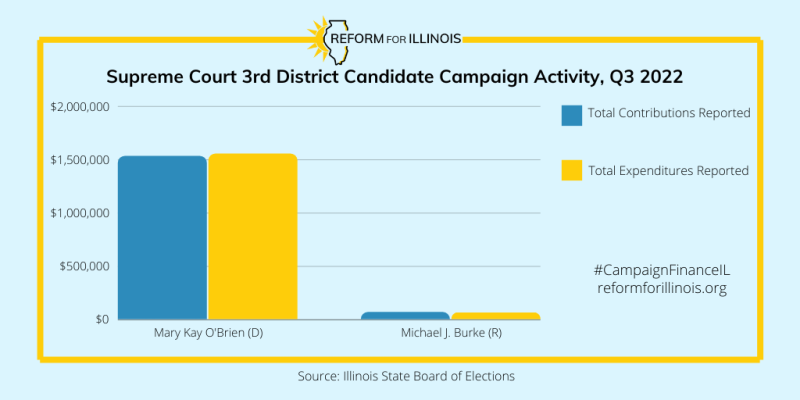
Read our report on the money in Illinois’ Supreme Court races here.
In the 3rd District, Justice Mary Kay O’Brien (D) raised an impressive $1.5 million during the third quarter, more than five times her second quarter total. Much like Judge Rochford in the 2nd District, O’Brien’s largest contribution this quarter was a $500K transfer from Gov. Pritzker. (Justice Burke self-funded back in April, meaning that contribution caps were raised to $500K in this race.) Her next largest contributions were $100K transfers from the Illinois Federation of Teachers COPE and I.P.A.C.E. O’Brien has another similarity with her counterpart in the 2nd District: her campaign received eleven $12K donations from law firms this quarter, including The Cates Law Firm LLC and the Law Offices of Parente & Norem PC. O’Brien was also the recipient of a $62K in-kind contribution for voter ID calling (to gauge the partisanship of voters in the 3rd District) from Personal PAC, in yet another similarity with Judge Rochford.
O’Brien spent about as much as she raised this quarter (another $1.5 million), which reflects the competitive nature of her race against Justice Burke. Her largest expenditure was for television ads, with $1.3 million paid out to Adelstein & Associates LLC. Other large expenses included survey research ($42K) and self/opposition research ($8K). O’Brien had $349K available at the close of the third quarter and has since raised another $1 million since September 30, leaving her with a healthy $1.4 million in her campaign account before Election Day.
Justice Michael J. Burke (R) had a less than stellar quarter: his campaign reported bringing in $63K, down from $106K in the second quarter. His largest contribution was a $25K transfer from Manufacturers PAC, and his largest individual contributions came from Craig Duchossois, CEO of The Duchossois Group ($6K), and Elizabeth Bishop of Peru, Illinois ($6K). Burke found more success with small-dollar contributions this quarter, raising 2.5% of his total haul (compared to just 0.79% for Justice O’Brien) from contributions of up to $150.
Burke spent $58K this quarter. His largest expenditure was $22K for media consulting, followed by promotional items ($11K) and fundraiser food ($7K). Burke ended the quarter with $304K in his campaign coffers, though he has raised another $414K in the last few weeks alone. Like his counterpart in the 2nd District, Burke also reported raising over $221K in a single day, likely from a fundraiser. Burke has $719K available to spend currently.
Secretary of State
Without a competitive Democratic primary, the money race for Secretary of State is largely settled: Alexi Giannoulias (D) has a massive lead compared to his opponent, Dan Brady (R). Giannoulias raised $3.1 million in the third quarter of 2022, while Dan Brady raised $318K.
Gubernatorial
Uihlein’s back and Pritzker ramps up spending – as does a pro-Bailey super PAC bankrolled by Uihlein; same super PAC is expanding to IL House and Senate races
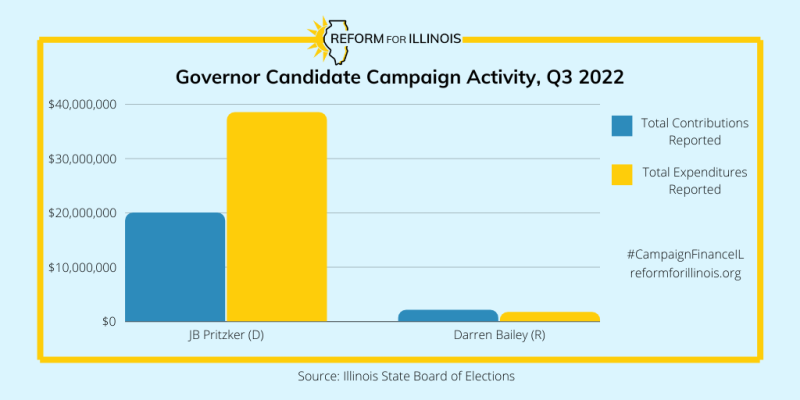
Gov. Pritzker maintained his runaway lead in the money race for governor, reporting a $20 million contribution of personal funds to his campaign account in the third quarter of 2022. Pritzker’s financial advantage in the governor’s race is nothing new: the billionaire governor is his campaign’s largest donor, and his wealth has flooded the field for the past few quarters. Just $4,489.91 (or 0.02%) of Pritzker’s total fundraising came from other sources this quarter. Just 0.16% of that $4,489.91 came from small-dollar contributions of up to $150.
Pritzker spent $38.4 million this quarter, up from $27 million in the second quarter. Of that, $15.2 million was for transfers to other Democratic candidates and committees. The largest transfers went to Democrats for the Illinois House ($6 million), the Democratic Party of Illinois ($3 million), ISDF ($1 million), Citizens for Giannoulias ($1 million), Raoul for Illinois ($1 million), and the Cook County Democratic Party ($1 million). Pritzker also transferred $500K each to Illinois Supreme Court candidates Elizabeth Rochford and Mary Kay O’Brien, which is the maximum allowable contribution under Illinois’ new restrictions on judicial contributions. As reported by Politico, Pritzker’s contributions to other Illinois Democrats are part of a larger strategy to support the party and Democrats up and down the ballot in Illinois.
Pritzker’s other expenditures this quarter totaled $23 million, with $16.7 million spent on media buys alone. Other top expenses for Pritzker’s campaign included voter outreach ($1.4 million) and event production ($930K). Pritzker ended the quarter with $42.3 million in his campaign coffers. Given that Pritzker’s spending has increased every quarter this year, we can reasonably expect some eye-popping spending in the final two weeks before Election Day.
On the Republican side, Darren Bailey’s fundraising faltered in the third quarter. After raising $8.6 million in the second quarter – $8 million of which came from billionaire Illinoisan Dick Uihlein –, Bailey reported just over $2 million in contributions this quarter. Reports circulated this summer that Uihlein was dissatisfied with Bailey’s campaign team, leading him to stop all direct contributions to Bailey’s campaign from late June until late August. Bailey’s lackluster fundraising in the third quarter is a direct result of Uihlein’s decision to give him the cold shoulder post-primary.
Bailey and Uihlein’s relationship thawed by the end of the summer. On August 29th, Uihlein resumed his direct contributions to Bailey’s campaign with a $1 million donation, Bailey’s largest contribution last quarter. All appears to be rosy between the Bailey and Uihlein camps for the time being, as evidenced by another $2 million contribution to Bailey from Uihlein on October 18th. Bailey and Uihlein hit a notable milestone recently too: Uihlein has now contributed more than $50 million to Bailey’s campaign and a pro-Bailey super PAC (discussed below), topping the $50 million contributed by Ken Griffin to Aurora Mayor Richard Irvin’s failed campaign during the primary.
Bailey’s next largest contributions this quarter included $150K from Alex Melvin, CEO of Rural King, a farm and home store based in Mattoon, IL; and $100K from Jean Bailey, Darren Bailey’s mother. Jean Bailey is Bailey’s second largest donor (behind Dick Uihlein), having contributed over $1 million to her son’s campaign since 2019. Melvin is Bailey’s third largest contributor overall: he has contributed over $350K since 2021. As for small-dollar contributions, Bailey raised about 7.5% of his total haul from contributions of up to $150.
Bailey’s slow fundraising quarter also meant fewer expenditures: he spent $1.6 million between July and the end of September, compared to $9.2 million during the second quarter. His largest expense was for a door knocking service, with $275K in reported expenditures to Higher Ground Strategies. His next largest expenditure was for consulting, printing, research, and media production services ($225K). Bailey entered the fourth quarter with $766K on hand, and his current cash on hand sits at $4.2 million in the lead up to the general election.
Despite the Bailey campaign’s money troubles, a well-resourced, Uihlein-backed super PAC has made sure that voters saw anti-Pritzker media over the last few months. The People Who Play By The Rules super PAC, created earlier this year by Dan Proft, spent $17.2 million this quarter – with $14.4 million going towards anti-Pritzker spending in the form of radio and television ads, digital advertising, mailings, consulting, and a website. People Who Play By The Rules’ ads have drawn criticism in recent weeks for their graphic nature, with some ads including footage of violent crimes in Chicago. The super PAC’s largest expenditures this quarter (totaling $2.8 million and excluding Pritzker-related independent expenditures) were for mailings ($948K) and consulting ($800K).
With Election Day just two weeks away, People Who Play By The Rules appears to be expanding its reach to additional races in Illinois. The super PAC’s most recent independent expenditure disclosures (filed on October 18th and 23rd) includes spending to support Stefanie Hood (Illinois House District 42), Michele Hunter (Illinois House District 54), Jennifer Korte (Illinois House District 112), Philip Nagel (Illinois Senate District 40), Jonathan Ojeda (Illinois House District 68), Jack Vrett (Illinois House District 53), Ken Hogan (Knox County Judge), Patrick Moody (Rock Island County Sheriff), Connie Cain (Illinois House District 66), Jennifer Korte (Illinois House District 112), “Republican Subcircuit Judges,” and Justice Michael J. Burke (Illinois Supreme Court 3rd District). Apart from the usual anti-Pritzker spending, the super PAC also spent in opposition to and in support of Lisa Smith (Illinois House District 96) and Matt Hansen (Illinois House District 83). This increased spending is a good indication that People Who Play By The Rules intends to be very active in the final few weeks of the campaign.
Dick Uihlein remains the super PAC’s largest donor, having contributed $20 million during the third quarter, for a total of $42 million since March. Three other donors to People Who Play By The Rules were reported this quarter: Kevin Cox of Oak Lawn, IL ($260.25); Nancy Jacobson, President of Kitchen Design Partners, Inc. ($255); and James Anderson of Wilmette, IL ($208.20). People Who Play By The Rules has $17.3 million cash on hand currently.
We’ll continue keeping an eye on the big money in Illinois races, but it’s always good to do your own research, too. Check out our easy-to-use database, Reform for Illinois’ Sunshine Campaign Finance Tracker, to see who’s funding — and influencing — your candidates and elected officials.
Back
